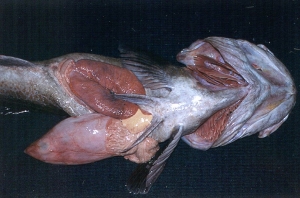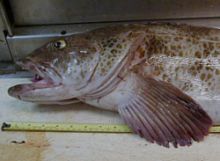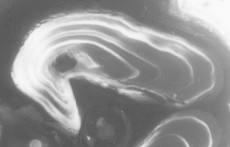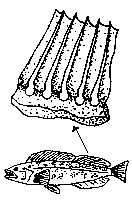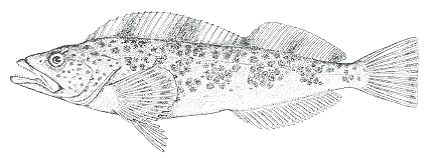Lingcod
Latin Name
Ophiodon elongatus
Group Name
Groundfish
Habitat
Native to the northeastern Pacific, lingcod occur from Alaska's Kodiak Island down to Baha California, with a particularly large concentration near the coast of British Columbia off Vancouver Island and the Queen Charlotte Islands, and in the Strait of Georgia, Hecate Strait and Queen Charlotte Sound. Lingcod prefer rocky areas, living on the bottom of the ocean from intertidal depths to about 100 metres.
Species Description
Lingcod are not a true cod. They have an elongated body with a long dorsal fin, and are generally a mottled brown, but can be grey, green or reddish-brown-even bluish. Their colouration gets lighter on their underside. Scales cover their body except for their head. Highly predatory, lingcod also have a very large mouth filled with sharp teeth. They can grow to more than a metre in length and weigh more than 30 kilograms, with females growing significantly larger than males (which rarely exceed 90 centimetres). Males live to about 14 years and females live to about 20 years.
Lingcod Life History
Lingcod (Ophiodon elongatus) are unique to the west coast of North America, with the centre of abundance off the coast of British Columbia. They are found on the bottom with most individuals occupying rocky areas at depths of 10-100 m. Tagging studies have shown that lingcod are a largely non-migratory species, with colonization and recruitment occurring in localized areas only.
Starting in October, lingcod migrate to nearshore spawning grounds. The males migrate first, and establish nest sites in strong current areas in rock crevices or on ledges. Spawning takes place between December and March, and females leave the nest site immediately after depositing eggs. Males actively defend the nest from predators until the eggs hatch in early March through late April. The photo to the right shows a nest-guarding male protecting his egg mass (photo by J. King).
The larvae are pelagic until late May or early June when they settle to the bottom as juveniles. Initially they inhabit eel grass beds, and eventually move to flat sandy areas that are not typical habitat of older lingcod. They eventually settle in habitats of similar relief and substrate as older lingcod, but remain at shallower depths for several years. (Photo: M. Surry)
Females and males mature at age 3-5 years (61-75 cm) and age 2 years (45 cm), respectively. Adult males can be distinguished externally from females by the presence of a small, conical papilla behind the anal vent. Up to age 2 males and females grow at similar rates, with both reaching an average length of 45 cm. After age 2, females grow faster than males, with the growth of males tapering off at about age 8, and females continuing to grow until about age 12-14. Lingcod live up to a maximum of about 14 years for males and 20 years for females, reaching a maximum size of approximately 90 cm and 120 cm, respectively.
Lingcod are voracious predators, feeding on invertebrates and many species of fish, including herring (Clupea pallasi) and Pacific hake (Merluccius productus). The above photo shows a lingcod that has been dissected to show a rockfish (Sebastes sp.) in the stomach (photo by S. Sviatko). Lingcod that survive the larval stages have few predators themselves, and are vulnerable mainly to marine mammals such as sea lions and harbour seals.
Lingcod Fishery
Lingcod (Ophiodon elongatus) have a long history of exploration as a food fish, starting with First Nations as early as 5,000 years ago, and it is known that they were fished by early settlers in the inshore waters around Victoria by the mid-1800's. (Photo: J. King)
The commercial fishery for lingcod in Canada began around 1860. The early fishery depended on handlining, or jigging, with live bait from small or medium sized vessels, and supplied local markets in Victoria on Vancouver Island. Prior to the development of the trawl fishery, lingcod were the main source of fresh fish available throughout the year, and between the turn of the century and the 1940s they were ranked fourth in economic importance behind salmon, herring, and sardines (pilchards).
Trawling was first conducted in Canadian waters around 1909 but operations remained small and close to the coast until the 1930s. By the early 1940s most areas off the British Columbia coast were being exploited by the trawl fishery, and trawl production now dominates the commercial fishery for lingcod in all areas outside the Strait of Georgia. Historically both Canada and the U.S. participated in the trawl fishery off the west coast of Canada, with the U.S. fishery contributing 40-60% of the total trawl catch in British Columbia. The U.S. fishery off British Columbia was prohibited in 1978 with the establishment of extended jurisdiction to the 200-mile limit in 1977.
Catches averaged around 300 t until about 1909, but rose steadily to a high of 5300 t in 1944. As the trawl fishery became established in the 1940s, the area of exploitation was extended to include the entire BC coast. Trawl catches rose steadily while handline catches gradually declined. In the 1950s and 60s coastwide total catch averaged 4000 t, reaching a record high of 6400 t in 1968, the largest catch on record. Coast wide catches declined sharply through the 1970s, but rose again soon after extended jurisdiction in 1977, reaching another record high of about 5600 t 1985. Coastwide catches were high in the early 1990s but have declined in recent years. The introduction in 1996 of on-board vessel observers, bycatch limits for halibut, and the provision that all catches of quota species, including discards, would be counted against individual vessel quotas, substantially changed the groundfish trawl fishery in BC, and has resulted in reduced targeting on lingcod.
Lingcod catch in the Strait of Georgia has been dominated by the hook and line fishery, with minor contributions by the trawl, longline, and recreational fishery. Catches in all sectors have decreased progressively since the 1950s, and by the late 1980s, both commercial and recreational catches in all areas of the Strait of Georgia had declined to low levels. Lingcod stocks in the Strait of Georgia are considered to be at a low level of abundance, and since the early 1990's, commercial fishing for lingcod has been prohibited in all areas of the Strait of Georgia.
Offshore lingcod are exploited primarily by the trawl fishery. The largest proportion of the catch is from the south west coast of Vancouver Island, with large catches also taken from Queen Charlotte Sound. Lingcod are also caught on the north west coast of Vancouver Island, in Hecate Strait, and on the north west coast of the Haida Gwaii. Offshore lingcod stocks are thought to be at a moderate level of abundance.
Age determination of Lingcod
In 1977, Dr. Dick Beamish and Doris Chilton of the Pacific Biological Station published an article showing that cross sections of the 4th to 8th fin rays from the second dorsal fin provided a method for estimating the age of lingcod. This method has since been validated by a mark-recapture study in which lingcod received an injection of oxytetracycline (OTC). Other methods of aging, such as those using scales and otoliths, were found to underestimate ages for older fish.
Ages are determined from fins in much the same manner as for other aging structures: sections of varying thickness are examined under a microscope, and the annuli, or rings, that are formed for each year of growth are counted and used to estimate the age. The cross sections must be made at right angles to the length of the fin ray, and it is therefore important that fins be dried flat, with the cut surface at right angles to the fin rays. In addition, the distance that the section is cut from the fin-ray base is important, and for this reason, all fins should be collected with the base intact.
One problem associated with using fin rays to age older fish, is that the fin-ray center may be resorbed, resulting in the loss of the first two annuli. It is therefore necessary to determine an average width for the first two annuli by examining the fins from juvenile fish. This measurement can then be used to estimate the position of the third annulus on older fish.
Lingcod Nesting
An interesting history trait of lingcod is their reproductive behaviour. In the fall, males begin to set up territories on rocky substrate. Spawning occurs in December through March, with the majority occurring from mid-January to mid-February. The females move into a spawning area at night to deposit their eggs (up to 490 000 for a 120 cm female). The eggs are deposited in crevices or under rocks, and become a firm, solid, cohesive mass. The male lingcod remains with the egg masses (also called nests) and actively guards them from predation. In one instance, a male lingcod was observed to use its mouth to pick up a sea star that was feeding on eggs. The lingcod carried the predator 2 m away from the nest site before releasing it. Male lingcod are known to be very aggressive when guarding a nest, and biting or chasing of divers, along with bodily protection of the nest is common. Nests will not survive predation if a male is removed from a nest. For this reason, winter closures for lingcod fishing have been put in place in some areas to protect nest guarding males. The males will guard the nest until the eggs hatch (about 5-11 weeks later), and often remain associated with a nest site after the nest disappears.
Research Documents
These stock assessment research documents can be downloaded from the Canadian Science Advisory Secretariat (CSAS) website (links below).
- 2011 Lingcod (Ophiodon elongatus) stock assessment and yield advice for outside stocks in British Columbia (2011/124 (CSAS ResDocs - 2011/124))
- 2005 Strait of Georgia Lingcod Management Framework (2005/048 (CSAS ResDocs - 2005/048))
- 2003 Strait of Georgia Lingcod Stock Assessment Framework (2003/062 (CSAS ResDocs - 2003/062))
- 2001 Strait of Georgia Lingcod Stock Assessment (2001/132 (CSAS ResDocs - 2001/132))
- 2000 BC Lingcod Stock Assessment (2000/164 (CSAS ResDocs - 2000/164))
Publications
- Surry, A.M. and King J.R. 2007. Lingcod (Ophiodon elongatus) egg mass and reef fish density SCUBA survey in the Strait of Georgia, February 13-27, 2007. Can. Tech Rep. Fish. Aquat. Sci. 2743: viii + 19 p.
- Surry, A.M., King, J.R., and Haggarty, D.R. 2007. Bottom trawl survey of young-of-the-year lingcod (Ophiodon enlongatus) in the Strait of Goergia, CCGS Neocaligus, July 28 - August 9, 2006. Can Tech. Rep. Fish. Aquat. Sci. 2740: x + 50 p.
- Haggarty, D.R., and King, J.R. 2007. Lingcod egg mass density survey in the Strait of Georgia, February – March, 2006. Can. Tech. Rep. Fish. Aquat. Sci. 2691: iv + 28 p.
- Haggarty, D.R. and King, J.R. 2006. CPUE as an index of relative abundance for nearshore reef fishes. Fisheries Research 81(1): 89-93.
- Haggarty, D.R., and King, J.R. 2006. Hook and line survey of Lingcod (Ophiodon elongatus) and Rockfish (Sebastes spp.) in southern Strait of Georgia (statistical areas 18 and 19) June 19-29, 2005. Can. Tech. Rep. Fish. Aquat. Sci. 2623: vii + 44 p.
- Logan, G., de la Mare, W., King, J., and Haggarty, D. 2005. Management Framework for Strait of Georgia Lingcod (CSAS resdocs - 2005/048). Can. Sci. Ad. Sec. Res. Doc. 2005/048.
- Surry, A.M., Haggarty, D.R., and King, J.R. 2005. Bottom trawl survey of young-of-the-year lingcod (Ophiodon elongatus) in the Strait of Georgia, July 26 - August 8, 2005. Can. Data Rep. Fish. Aquat. Sci. 1170. vii + 45 p.
- Haggarty, D.R., King, J.R., and Hodes, V.R. 2005. Lingcod egg mass and reef fish density SCUBA survey in the Strait of Georgia, February 19 – March 11, 2005. Can. Data Rep. Fish. Aquat. Sci. 1161: iv + 16 p.
- Haggarty, D.R., and King J.R. 2005. Hook and line survey of Lingcod (Ophiodon elongatus) and Rockfish (Sebastes spp.) in northern Strait of Georgia (statistical areas 13 14, 15 and 16) Jun 14-July 9, 2004. Can. Tech. Rep. Fish. Aquat. Sci. 2590: 57p.
- Haggarty, D.R., King, J.R., Surry, A.M., and Mathias, K.L. 2005. Bottom trawl survey of young-of-the-year lingcod (Ophiodon elongatus) in the Strait of Georgia, July 13 – 26, 2004. Can. Tech. Rep. Fish. Aquat. Sci. 2589: 53 p.
- King, J.R. and R.E. Withler. 2005. Male nest site fidelity and female serial polyandry in lingcod (Ophiodon elongatus, Hexagrammidae). Molecular Ecology 14: 653-660.
Note :
This is an electronic version of an article published in Molecular Ecology: complete citation information for the final version of the paper, as published in the print edition of Molecular Ecology, is available on the Blackwell Synergy online delivery service.
- Haggarty, D.R. and J.R. King. 2004. Hook and line survey of lingcod (Ophiodon elongatus) and rockfish (Sebastes sp.) stocks in southern Strait of Georgia (Statistical Areas 17, 18, and 19), October 2003. Can. Tech. Rep. Fish. Aquat. Sci. 2533: 38 p.
- Haggarty, D.R., J.R. King, and K.L. Mathias. 2004. Bottom trawl survey of young-of-the-year lingcod (Ophiodon elongatus) in the Strait of Georgia by the R/V Neocaligus, July 28-August 9, 2003. Can. Man. Rep. Fish. Aquat. Sci. 2673: 39 p.
- King, J.R., and Haggarty, D.R. 2004. An examination of recapture rates of lingcod as a potential source of bias in recreational catch per unit effort (CPUE) indices. Can. Man. Rep. Fish. Aquat. Sci. 2670: 39 p.
- King, J. R. and Haggarty, D.R. 2004. Lingcod egg mass and reef fish density SCUBA survey in the Strait of Georgia, February 17 - March 3, 2004. Can. Data Rep. Fish. Aquat. Sci. 1147: iv + 13 p.
- Withler, R.E., J.R. King, J.B. Marliave, B. Beaith, S. Li, K.J. Supernault and K.M. Miller. 2004. Polygamous mating and high levels of genetic variation in lingcod (Ophiodon elongatus) of the Strait of Georgia, British Columbia. Env. Biol. Fish. 69(1-4): 345-357.
- King, J.R., G.A. McFarlane, and A.M. Surry. 2003. Stock Assessment Framework for Strait of Georgia Lingcod (CSAS resdocs - 2003/062). Can. Sci. Ad. Sec. Res. Doc. 2003/062. 57 p.
- Surry, A.M. and J.R. King. 2003. Diameter measurements for identification of the first and second annulus on dorsal fin ray sections from lingcod (Ophiodon elongatus). Can. Tech. Rep. Fish. Aquat. Sci. 2490: 24 p.
- King, J.R. and p. Winchell. 2002. Lingcod (Ophiodon elongatus) Nest Density SCUBA Survey in the Strait of Georgia, February 1-March 13, 2002. Can. Tech. Rep. Fish. Aquat. Sci. 2437: 16 p.
- King, J.R. and B.W. Beaith. 2001. Lingcod (Ophiodon elongatus) Nest Density SCUBA Survey in the Strait of Georgia, January 16-April 26, 2001. Can. Tech. Rep. Fish. Aquat. Sci. 2374. 23 p.
- King, J.R. 2001. Assessment of lingcod in the Strait of Georgia (CSAS resdocs - 2001/132). Can. Sci. Ad. Sec. Res. Doc. 2001/132. 41 p.
- McFarlane, G.A., and J.R. King. 2001. The validity of the fin-ray method of age determination for lingcod (Ophiodon elongatus) (CSAS ResDocs - 2003/062). Fishery Bulletin 99(3): 459-464.
- King, J.R. and A.M. Surry. 2001. Lingcod stock assessment and recommended yield options for 2001 (CSAS resdocs - 2000/164). Canadian Stock Assessment Secretariat Research Document 2000/164. 50p.
- Cass, A.J., R.J. Beamish, and G.A. McFarlane. 1990. Lingcod (Ophiodon elongatus). Can. Spec. Publ. Fish. Aquat. Sci. 109: 40 p.
- Beamish, R.J. and D. Chilton. 1977. Age determination of lingcod (Ophiodon elongatus) using dorsal fin rays and scales. J. Fish. Res. Board Can. 27:1305-1313.
- Date modified:




